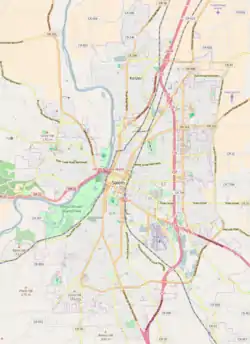Bligh Building/Pacific Building | |
 | |
  | |
| Location | 508–524 State Street Salem, Oregon |
|---|---|
| Coordinates | 44°56′22″N 123°2′13″W / 44.93944°N 123.03694°W |
| Built | 1926 |
| Architect | Tourtellotte[1] & Hummel |
| Architectural style | Commercial style |
| Part of | Salem Downtown State Street – Commercial Street Historic District (ID01001067) |
| Added to NRHP | September 28, 2001 |
The Capitol Theater was located at 542 State Street in Salem, Oregon, United States. Part of the Bligh Building, it was built in the 1920s for vaudeville. During its heyday, it housed a Wurlitzer pipe organ, which is now in private ownership in Washington.[2][3] The theater was demolished in 2000, but the retail portion of the building, now known as the Pacific Building, still stands.[4]
Bligh Building and Capitol Theater

The building, constructed in 1926 for owner Frank D. Bligh, covered a quarter of a block. At the time it was built, it had twelve storefronts and thirty-five rooms designed for offices, as well as what was known at the time as the New Bligh Capitol Theater, with 1,200 seats.[5] Bligh owned several theaters in Salem, including the original Bligh Theater built in 1912 and closed in 1927.[5] For a time Bligh owned the Klinger Grand Theater, which he also renamed Bligh Theater.[5] The Capitol Theater's brightly lit marquee was constructed of stained glass in the shape of the dome of the second Oregon State Capitol building, which was destroyed in a 1935 fire.[1]
Decline and demolition

The theater converted from vaudeville to movies. By 1952 the glass dome marquee had been replaced.[6] By the 1980s, it was one of only two pre-World War II theaters left in downtown Salem, which had once hosted as many as eight. Like its neighbor, the Elsinore Theatre, the Capitol declined to a second-run movie house. It was closed in 1990.[7]
The Capitol Theater was demolished in May/June 2000[3] because of structural decay. The location is now a parking lot, however, the adjoining office and retail space remains. This retail building, known as the Bligh Building and currently as the Pacific Building, is a contributing property of the Salem Downtown State Street-Commercial Street Historic District, which is listed on the National Register of Historic Places.[8]
Theater organ
The theater's 3/8 (3-manual/8-rank) "Mighty Wurlitzer" theatre organ was installed in 1926.[2] In 1941, the organ was moved to Seattle's Civic Ice Arena.[2] In 1964–65, the organ was moved to the Seattle Center Food Circus. It was sold at auction in 1976, and is currently installed in a private home in Washington, combined with parts from Portland's Majestic/United Artists Theatre organ to make a 3/18 Wurlitzer.[2]
References
- 1 2 "Capitol Theater". The Oregon Encyclopedia.
- 1 2 3 4 "Capitol Theatre". Puget Sound Theatre Organ Society. Retrieved February 20, 2012.
- 1 2 "Salem's Theatrical History". Salem Online History: Salem Public Library. Retrieved February 20, 2012.
- ↑ "Salem Downtown State Street-Commercial Street Historic District National Register of Historic Places Registration Form". National Park Service. August 2, 2001. p. 94. Retrieved February 20, 2012.
- 1 2 3 Clark, Robert Carlton (1927). History of the Willamette Valley Oregon: Frank D. Bligh. Vol. 3. Chicago: Chapman Publishing Company. p. 158. OCLC 4711206. Archived from the original on December 23, 2015. Retrieved April 5, 2018.
- ↑ West, Robert D. "Salem, Oregon Places: Historic Downtown". Archived from the original on August 28, 2008. Retrieved February 20, 2012.
- ↑ Green, Virginia (July 23, 2010). "Salem in 1990". Salem Heritage Network. Retrieved February 20, 2012.
- ↑ "508-524 State Street". Salem Online History: Salem Public Library. Retrieved February 20, 2012.
External links
- "Capitol Theater". The Oregon Encyclopedia.
- Capitol Theater from Cinema Treasures
- Historic images of Capitol Theater from Salem Public Library
- Facade of theater in 1980
- Image of Capitol Theater from 1999 from Salemoregon.com
- Zimmerman, Andy (November 16, 2013). "SJ time capsule: Capitol Theatre, an entertainment destination until the '90s". Statesman Journal. Archived from the original on November 18, 2013. Retrieved April 5, 2018.

